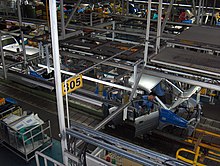
Back Massaproduksie Afrikaans إنتاج كبير Arabic Producción en cadena AST Kütləvi istehsal Azerbaijani Масово производство Bulgarian গণ-উৎপাদন Bengali/Bangla Producció en cadena Catalan Sériová výroba Czech Masseproduktion Danish Massenproduktion German
This article includes a list of general references, but it lacks sufficient corresponding inline citations. (January 2021) |
| Part of a series of articles on |
| Machine industry |
|---|
 |
| Manufacturing methods |
| Industrial technologies |
| Information and communication |
| Process control |

Mass production, also known as flow production, series production, series manufacture, or continuous production, is the production of substantial amounts of standardized products in a constant flow, including and especially on assembly lines. Together with job production and batch production, it is one of the three main production methods.[1]
The term mass production was popularized by a 1926 article in the Encyclopædia Britannica supplement that was written based on correspondence with Ford Motor Company. The New York Times used the term in the title of an article that appeared before the publication of the Britannica article.[2]
The idea of mass production is applied to many kinds of products: from fluids and particulates handled in bulk (food, fuel, chemicals and mined minerals), to clothing, textiles, parts and assemblies of parts (household appliances and automobiles).
Some mass production techniques, such as standardized sizes and production lines, predate the Industrial Revolution by many centuries; however, it was not until the introduction of machine tools and techniques to produce interchangeable parts were developed in the mid-19th century that modern mass production was possible.[2]
- ^ Production Methods Archived 14 July 2017 at the Wayback Machine, BBC GCSE Bitesize, retrieved 26 October 2012.
- ^ a b Hounshell, David A. (1984), From the American System to Mass Production, 1800–1932: The Development of Manufacturing Technology in the United States, Baltimore, Maryland: Johns Hopkins University Press, ISBN 978-0-8018-2975-8, LCCN 83016269, OCLC 1104810110